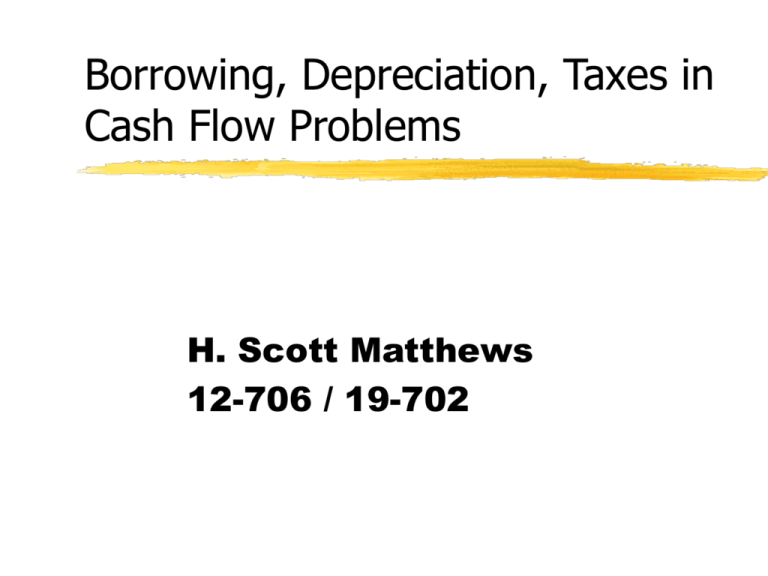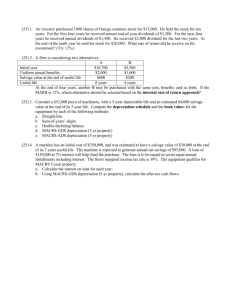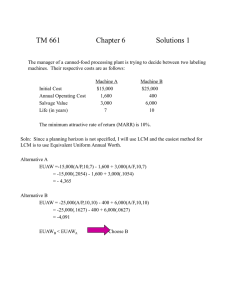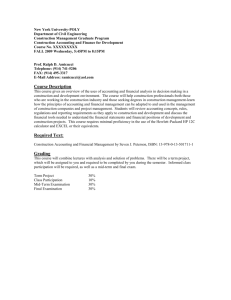Borrowing, Depreciation, Taxes in Cash Flow Problems
advertisement

Borrowing, Depreciation, Taxes in Cash Flow Problems H. Scott Matthews 12-706 / 19-702 Theme: Cash Flows Streams of benefits (revenues) and costs over time => “cash flows” We need to know what to do with them in terms of finding NPV of projects Different perspectives: private and public We will start with private since its easier Why “private..both because they are usually of companies, and they tend not to make studies public Cash flows come from: operation, financing, taxes Without taxes, cash flows simple A = B - C Cash flow = benefits - costs Or.. Revenues - expenses Notes on Tax deductibility Reason we care about financing and depreciation: they affect taxes owed For personal income taxes, we deduct items like IRA contributions, mortgage interest, etc. Private entities (eg businesses) have similar rules: pay tax on net income Income = Revenues - Expenses There are several types of expenses that we care about Interest expense of borrowing Depreciation (can only do if own the asset) These are also called ‘tax shields’ Goal: Cash Flows after taxes (CFAT) Master equation conceptually: CFAT = -equity financed investment + gross income - operating expenses + salvage value taxes + (debt financing receipts disbursements) + equity financing receipts Where “taxes” = Tax Rate * Taxable Income Taxable Income = Gross Income - Operating Expenses - Depreciation - Loan Interest - Bond Dividends Most scenarios (and all problems we will look at) only deal with one or two of these issues at a time Investment types Debt financing: using a bank or investor’s money (loan or bond) DFD:disbursement (payments) DFR:receipts (income) DFI: portion tax deductible (only non-principal) Equity financing: using own money (no borrowing) Why Finance? Time shift revenues and expenses construction expenses paid up front, nuclear power plant decommissioning at end. “Finance” is also used to refer to plans to obtain sufficient revenue for a project. Borrowing Numerous arrangements possible: bonds and notes (pay dividends) bank loans and line of credit (pay interest) municipal bonds (with tax exempt interest) Lenders require a real return - borrowing interest rate exceeds inflation rate. Issues Security of loan - piece of equipment, construction, company, government. More security implies lower interest rate. Project, program or organization funding possible. (Note: role of “junk bonds” and rating agencies. Variable versus fixed interest rates: uncertainty in inflation rates encourages variable rates. Issues (cont.) Flexibility of loan - can loan be repaid early (makes re-finance attractive when interest rates drop). Issue of contingencies. Up-front expenses: lawyer fees, taxes, marketing bonds, etc.- 10% common Term of loan Source of funds Sinking Funds Act as reverse borrowing - save revenues to cover end-of-life costs to restore mined lands or decommission nuclear plants. Low risk investments are used, so return rate is lower. Recall: Annuities (a.k.a uniform values) Consider the PV of getting the same amount ($1) for many years Lottery pays $A / yr for n yrs at i=5% A A A A PV 1i (1i) .. 2 (1i)3 (1i)n A A A PV * (1 i) A (1i) (1i) .. 2 (1i)n1 ----- Subtract above 2 equations.. ------A PV * (1 i) PV A (1i) n n 1 PV *(i) A(1 (1i) ) A(1 (1 i) ) n PV A (1(1i) n ) i When A=1 the right hand side is called the “annuity factor” Uniform Values - Application Note Annual (A) values also sometimes referred to as Uniform (U) .. $1000 / year for 5 years example P = U*(P|U,i,n) = (P|U,5%,5) = 4.329 P = 1000*4.329 = $4,329 Relevance for loans? Borrowing Sometimes we don’t have the money to undertake - need to get loan i=specified interest rate At=cash flow at end of period t (+ for loan receipt, - for payments) Rt=loan balance at end of period t It=interest accrued during t for Rt-1 Qt=amount added to unpaid balance At t=n, loan balance must be zero Equations i=specified interest rate At=cash flow at end of period t (+ for loan receipt, - for payments) It=i * Rt-1 Qt= At + It Rt= Rt-1 + Qt <=> Rt= Rt-1 + At + It Rt= Rt-1 + At + (i * Rt-1) Annual, or Uniform, payments Assume a payment of U each year for n years on a principal of P Rn=-U[1+(1+i)+…+(1+i)n-1]+P(1+i)n Rn=-U[((1+i)n-1)/i] + P(1+i)n Uniform payment functions in Excel Same basic idea as earlier slide Example Borrow $200 at 10%, pay $115.24 at end of each of first 2 years R0=A0=$200 A1= -$115.24, I1=R0*i = (200)*(.10)=20 Q1=A1 + I1 = -95.24 R1=R0+Qt = 104.76 I2=10.48; Q2=-104.76; R2=0 Various Repayment Options Single Loan, Single payment at end of loan Single Loan, Yearly Payments Multiple Loans, One repayment Notes Mixed funds problem - buy computer Below: Operating cash flows At Four financing options (at 8%) in At section below t 0 1 2 3 4 5 At (Operation) -22,000 6,0 00 6,0 00 6,0 00 6,0 00 6,0 00 2,0 00 10,000 -14,693 At (Fin ancing) 10,000 10,000 -2,5 05 -800 -2,5 05 -800 -2,5 05 -800 -2,5 05 -800 -2,5 05 -10,800 10,000 -2,8 00 -2,6 40 -2,4 80 -2,3 20 -2,1 60 Further Analysis (still no tax) t At 8% (Opera tion ) 0 -22 ,000 1 6,000 2 6,000 3 6,000 4 6,000 5 6,000 2,000 NPV 33 17.4 27 10 ,000 -14 ,693 0.1911 At (Fi nancing at 8%) 10 ,000 10 ,000 -2,505 -80 0 -2,505 -80 0 -2,505 -80 0 -2,505 -80 0 -2,505 -10 ,800 -1.7386 0 10 ,000 -2,800 -2,640 -2,480 -2,320 -2,160 1E-1 2 -12 ,000 6,000 6,000 6,000 6,000 -8,693 2,000 33 17.6 2 A* (To tal pre-ta x) -12 ,000 -12 ,000 3,495 5,200 3,495 5,200 3,495 5,200 3,495 5,200 3,495 -4,800 2,000 2,000 33 15.6 9 33 17.4 MARR (disc rate) equals borrowing rate, so financing plans equivalent. When wholly funded by borrowing, can set MARR to interest rate -12 ,000 3,200 3,360 3,520 3,680 3,840 2,000 33 17.4 3 Effect of other MARRs (e.g. 10%) t At 10 % (Opera tion ) 0 -22 ,000 1 6,000 2 6,000 3 6,000 4 6,000 5 6,000 2,000 NPV 19 86.5 63 10 ,000 -14 ,693 87 6.8 At (Fi nancing at 8%) 10 ,000 10 ,000 -2,505 -80 0 -2,505 -80 0 -2,505 -80 0 -2,505 -80 0 -2,505 -10 ,800 50 4.08 75 8.16 10 ,000 -2,800 -2,640 -2,480 -2,320 -2,160 48 3.69 -12 ,000 6,000 6,000 6,000 6,000 -8,693 2,000 28 63.3 7 A* (To tal pre-ta x) -12 ,000 -12 ,000 3,495 5,200 3,495 5,200 3,495 5,200 3,495 5,200 3,495 -4,800 2,000 2,000 24 90.6 4 27 44.7 ‘Total’ NPV higher than operation alone for all options All preferable to ‘internal funding’ Why? These funds could earn 10% ! First option ‘gets most of loan’, is best -12 ,000 3,200 3,360 3,520 3,680 3,840 2,000 24 70.2 5 Effect of other MARRs (e.g. 6%) t At 6% (Opera tion ) 0 -22 ,000 1 6,000 2 6,000 3 6,000 4 6,000 5 6,000 2,000 NPV 47 68.6 99 -14 ,693 At (Fi nancing at 8%) 10 ,000 10 ,000 -2,505 -80 0 -2,505 -80 0 -2,505 -80 0 -2,505 -80 0 -2,505 -10 ,800 10 ,000 -2,800 -2,640 -2,480 -2,320 -2,160 -97 9.46 -55 1.97 -52 5.1 10 ,000 -84 2.5 -12 ,000 6,000 6,000 6,000 6,000 -8,693 2,000 37 89.2 3 A* (To tal pre-ta x) -12 ,000 -12 ,000 3,495 5,200 3,495 5,200 3,495 5,200 3,495 5,200 3,495 -4,800 2,000 2,000 42 16.7 3 39 26.2 Now reverse is true Why? Internal funds only earn 6% ! First option now worst -12 ,000 3,200 3,360 3,520 3,680 3,840 2,000 42 43.6 1 Bonds Done similar to loans, but mechanically different Usually pay annual interest only, then repay interest and entire principal in yr. n Similar to financing option #3 in previous slides There are other, less common bond methods Tax Effects of Financing Companies deduct interest expense Bt=total pre-tax operating benefits Excluding loan receipts Ct=total operating pre-tax expenses Excluding loan payments At= Bt- Ct = net pre-tax operating cash flow A,B,C: financing cash flows A*,B*,C*: pre-tax totals / all sources Depreciation Decline in value of assets over time Buildings, equipment, etc. Accounting entry - no actual cash flow Systematic cost allocation over time Main emphasis is to reduce our tax burden Government sets dep. Allowance P=asset cost, S=salvage,N=est. life Dt= Depreciation amount in year t Tt= accumulated (sum of) dep. up to t Bt= Book Value = Undep. amount = P - Tt After-tax cash flows Dt= Depreciation allowance in t It= Interest accrued in t + on unpaid balance, - overpayment Qt= available for reducing balance in t Wt= taxable income in t; Xt= tax rate Tt= income tax in t Yt= net after-tax cash flow Equations Dt= Depreciation allowance in t It= Interest accrued in t Qt= available for reducing balance in t So At = Qt - It Wt= At - Dt - It (Operating - expenses) Tt= Xt Wt Yt= A*t - Xt Wt (pre tax flow - tax) OR Yt= At + At - Xt (At-Dt -It) Simple example Firm: $500k revenues, $300k expense Depreciation on equipment $20k No financing, and tax rate = 50% Yt= At + At - Xt (At-Dt -It) Yt=($500k-$300k)+0-0.5 ($200k-$20k) Yt= $110k Depreciation Example Simple/straight line dep: Dt= (P-S)/N Equal expense for every year $16k compressor, $2k salvage at 7 yrs. Dt= (P-S)/N = $14k/7 = $2k Bt= 16,000-2t, e.g. B1=$14k, B7=$2k Salvage Value is an investing activity that is considered outside the context of our income tax calculation If we sell asset for salvage value, no further tax implications (IN THIS COURSE WE ASSUME THIS TO SIMPLIFY) If we sell asset for higher than salvage value, we pay taxes since we received depreciation expense benefits (but we will generally ignore this since its not the focus of the course) We show salvage value on separate lines to emphasize this. Accelerated Dep’n Methods Depreciation greater in early years Sum of Years Digits (SOYD) Let Z=1+2+…+N = N(N+1)/2 Dt= (P-S)*[N-(t-1)]/Z, e.g. D1=(N/Z)*(P-S) D1=(7/28)*$14k=$3,500, D7=(1/28)*$14k Declining balance: Dt= Bt-1*r (where r is rate) Bt=P*(1-r)t, Dt= P*r*(1-r)t-1 Requires us to keep an eye on B Typically r=2/N - aka double dec. balance Ex: Double Declining Balance Could solve P(1-r)N = S (find nth root) t 0 1 2 3 4 5 6 7 Dt (2/7)*$16k=$4,571.43 (2/7)*$11,428=$3265.31 $2332.36 $1,665.97 $1,189.98 $849.99 $607.13** Bt $16,000 $11,428.57 $8,163.26 $5,830.90 $4,164.93 $2,974.95 $2,124.96 $1,517.83** Notes on Example Last year would need to be adjusted to consider salvage, D7=$124.96 We get high allowable depreciation ‘expenses’ early - tax benefit We will assume taxes are simple and based on cash flows (profits) Realistically, they are more complex First Complex Example Firm will buy $46k equipment Yr 1: Expects pre-tax benefit of $15k Yrs 2-6: $2k less per year ($13k..$5k) Salvage value $4k at end of 6 years No borrowing, tax=50%, MARR=6% Use SOYD and SL depreciation Results - SOYD t At 6% (Pre-ta x) 0 -46,000 1 15,000 2 13,000 3 11,000 4 9,0 00 5 7,0 00 6 5,0 00 4,0 00 NPV 766 1.00 4 SOYD Dt 12,000 10,000 8,0 00 6,0 00 4,0 00 2,0 00 Tax Inco me Wt 3,0 00 3,0 00 3,0 00 3,0 00 3,0 00 3,0 00 Inc Ta x Tt 1,5 00 1,5 00 1,5 00 1,5 00 1,5 00 1,5 00 Aft-Tax Yt -46,000 13,500 11,500 9,5 00 7,5 00 5,5 00 3,5 00 4,0 00 285 .02 D1=(6/21)*$42k = $12,000 SOYD really reduces taxable income! Results - Straight Line Dep. t At 6% (Pre-ta x) 0 -46,000 1 15,000 2 13,000 3 11,000 4 9,0 00 5 7,0 00 6 5,0 00 4,0 00 NPV 766 1.00 4 SL Dt 7,0 00 7,0 00 7,0 00 7,0 00 7,0 00 7,0 00 Tax Inco me Wt 8,0 00 6,0 00 4,0 00 2,0 00 0 -2,0 00 Inc Ta x Tt Aft-Tax Yt -46,000 4,0 00 11,000 3,0 00 10,000 2,0 00 9,0 00 1,0 00 8,0 00 0 7,0 00 -1,0 00 6,0 00 4,0 00 -548 .9 NPV negative - shows effect of depreciation Negative tax? Typically treat as credit not cash back Projects are usually small compared to overall size of company this project would “create tax benefits” Let’s Add in Interest - Computer Again Price $22k, $6k/yr benefits for 5 yrs, $2k salvage after year 5 Borrow $10k of the $22k price Consider single payment at end and uniform yearly repayments Depreciation: Double-declining balance Income tax rate=50% MARR 8% Single Repayment t At At 8% (Operation) (Loa n 8% ) 0 -22,000 10,000 1 6,0 00 2 6,0 00 3 6,0 00 4 6,0 00 5 6,0 00 -14,693 2,0 00 NPV 331 7.42 7 0.1 9109 Bt 22,000 13,200 7,9 20 4,7 52 2,8 51 2,0 00 Dt 8,8 00 5,2 80 3,1 68 1,9 01 851 Rt 100 00 108 00 116 64 125 97 136 05 146 93 It 800 864 933 1,0 08 1,0 88 Wt -3,6 00 -144 1,8 99 3,0 91 4,0 61 Tt -180 0 -72 949 .44 154 5.7 203 0.3 Yt -12,000 7,8 00 6,0 72 5,0 51 4,4 54 -10,723 2,0 00 177 4.38 Had to ‘manually adjust’ Dt in yr. 5 Note loan balance keeps increasing Only additional interest noted in It as interest expense Uniform payments t At At 8% (Operation) (Loa n 8% ) 0 -22,000 10,000 1 6,0 00 -2,5 05 2 6,0 00 -2,5 05 3 6,0 00 -2,5 05 4 6,0 00 -2,5 05 5 6,0 00 -2,5 05 2,0 00 NPV 331 7.42 7 -1.7 386 Bt 22,000 13,200 7,9 20 4,7 52 2,8 51 2,0 00 Dt 8,8 00 5,2 80 3,1 68 1,9 01 851 Rt 100 00 829 5 645 3.6 446 4.9 231 7.1 -2.5 55 It Wt 800 664 516 357 185 -3,6 00 56 2,3 16 3,7 42 4,9 64 Tt -180 0 28.2 115 7.9 187 1 248 1.8 Note loan balance keeps decreasing NPV of this option is lower - should choose previous (single repayment at end).. not a general result Yt -12,000 5,2 95 3,4 67 2,3 37 1,6 24 1,0 13 2,0 00 974 .707 Leasing ‘Make payments to owner’ instead of actually purchasing the asset Since you do not own it, you can not take depreciation expense Lease payments are just a standard expense (i.e., part of the Ct stream) At= Bt - Ct ; Yt= At - At Xt Tradeoff is lower expenses vs. loss of depreciation/interest tax benefits






